“Mr. Darcy they had seen only at church.”–Pride and Prejudice
We’ve been enjoying the wonderful illustrations in Hugh Thomson’s “Peacock” Pride and Prejudice. Many of them show everyday life in Jane Austen’s England. Last week we saw what it might mean for a young lady to be accomplished in “covering screens.” Today we’ll look at another picture that may surprise you: the inside of a Georgian-era church.
Mr. Darcy at Church
When Elizabeth Bennet and Maria Lucas are visiting Charlotte Lucas Collins at Hunsford, Mr. Darcy and Colonel Fitzwilliam come to see their aunt, Lady Catherine de Bourgh. The gentlemen call on the ladies at the parsonage once, and Colonel Fitzwilliam visits again during the following week, but they next see Mr. Darcy at church. Thomson pictures the scene:
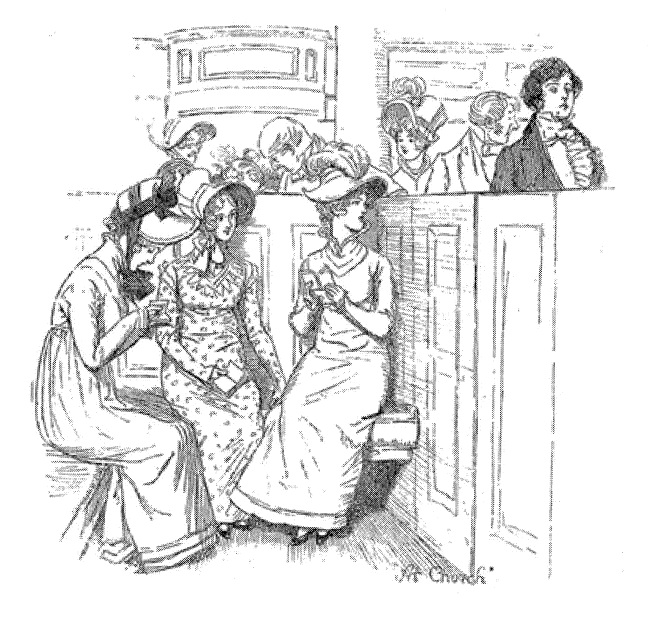
The ladies are sitting in the Collins’s family box pew, watching Darcy pass by. At churches in Austen’s England, families with money rented, or bought, box pews on the main floor of the church. Poorer people sat on benches in the back of the church, sat in the balconies (called galleries), or stood wherever they could.
The box pews were benches surrounded by walls. These walls kept out drafts in the cold churches and gave the family some privacy. Fees for these pews helped to pay for church expenses. The pews could even be locked to keep others out.
Similar Pews in Williamsburg, VA
How accurate is Thomson’s illustration? It reminded me of the box pews I saw at the Bruton Parish Church in Colonial Williamsburg, when I attended the JASNA AGM last fall. Their website says such “pews with doors were typical of unheated eighteenth-century English churches.”
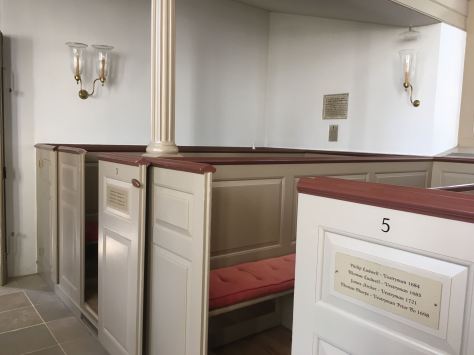
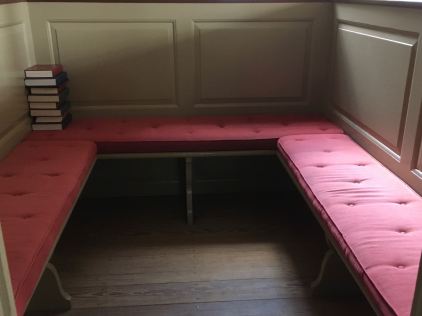
The Squire’s Box Pew
Some box pews had much higher walls than these. The Digweed box pew at Jane Austen’s church in the small village of Steventon is an example. It was for the squire’s family to sit in, and was originally at the front of the church.
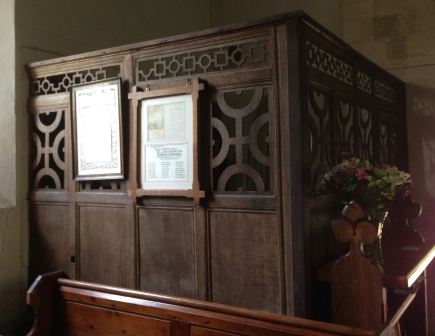
Raised Pulpits
How could the congregation see and hear the preacher, if some of them were surrounded by high walls? The clergyman probably preached from a high pulpit, with two or three levels, so that those in the box pews and those in the galleries could see him, and he could see them.
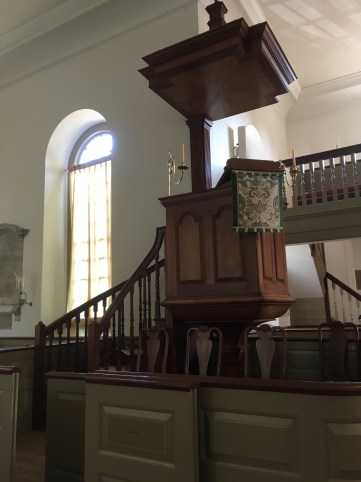
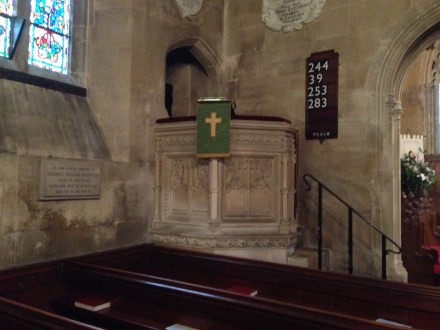
Many aspects of life in Austen’s England were different than they are today, including seating arrangements in church. If you were well-off, you had your own private pew where you and your family might sit across from each other. If not, you would be much less comfortable.
During Jane Austen’s lifetime, the first “free church” was built in Bath. Christ Church was paid for by donations. Seating on the main floor was free for poor families, while wealthier families rented pews in the galleries (balconies) to help pay church expenses.
If you attend church, do you have your favorite pew where your family always sits? What do you think it would be like to have to pay for your seating in church, or be relegated to the back if you couldn’t afford to pay?
In the Bible, James chapter 2 begins: “My brothers and sisters, believers in our glorious Lord Jesus Christ must not show favoritism. 2 Suppose a man comes into your meeting wearing a gold ring and fine clothes, and a poor man in filthy old clothes also comes in. 3 If you show special attention to the man wearing fine clothes and say, “Here’s a good seat for you,” but say to the poor man, “You stand there” or “Sit on the floor by my feet,” 4 have you not discriminated among yourselves and become judges with evil thoughts? 5 Listen, my dear brothers and sisters: Has not God chosen those who are poor in the eyes of the world to be rich in faith and to inherit the kingdom he promised those who love him?” James goes on to call favoritism “sin,” and reminds us to love our neighbors as we love ourselves.
In churches you are familiar with today, do you see examples of discrimination against those with who have fewer financial resources than others do? How can we better love one another in our churches?
Other posts on Hugh Thomson’s illustrations
The Joy of Hugh Thomson’s Peacock Pride and Prejudice
Covering Screens: A Young Lady’s Accomplishment
Discover more from Faith, Science, Joy, and Jane Austen
Subscribe to get the latest posts sent to your email.
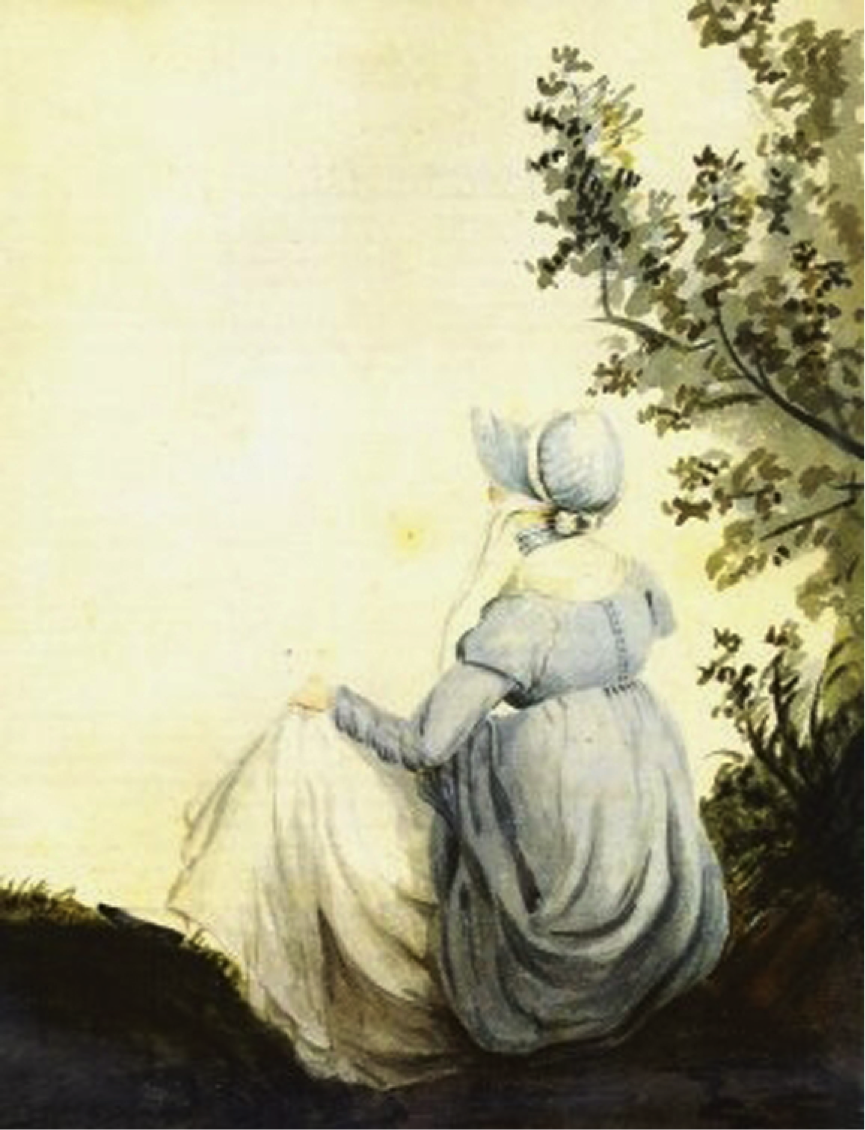


It is my understanding that Anglican churches rented out pews on a yearly basis to insure income. The benefit of this was obvious as most people are pleased to be seen as big donors when they are seated towards the front of the church. When churches changed to open seating the churches began asking for a yearly pledge instead. I suspect more money was raised with the previous plan. Also people have radically changed in that they have to be forced to sit towards the front these days. Preferred pews, however, are very much the thing and woe betide the stranger who sits in someone else’s pew.
LikeLike
Thanks for these thoughts, JoAnn! Yes, they rented out pews, or seats, for income, especially in city churches. Though it was a little more complicated in country churches, where some pews were owned by people who had built them (or had them built) themselves. And in some churches seating was assigned by a church official, who told people where to sit based on their status in society.
I wonder if the aversion to sitting in the front nowadays is because you feel more exposed and obvious up front. In box pews, you would feel more private and so it wouldn’t be as uncomfortable to be in the front.
I think whether people nowadays have preferred pews depends on the church. In churches we and our adult children attend, people have preferred parts of the sanctuary to sit in, but usually not a specific pew. I would imagine in very traditional churches it might be different.
When we went to Alton for a special Austen evensong service a few years ago, we came in a little late and chose an empty pew. Someone else appeared a little while later and seemed rather miffed that we were in “their” pew (we didn’t know it was theirs, of course!). But someone else in the church, who overheard, apologized to us afterwards! There weren’t assigned pews, but as you say, people have habits of where they like to sit.
LikeLike
It was fun to visit Bruxton Parish and sit in Thomas Ballard’s pew— my ancestor!
LikeLike
That’s great, Michelle! Not to burst your bubble, but they said the names on the pews were added later, names of famous people, not necessarily who sat there.But maybe he did!
LikeLike